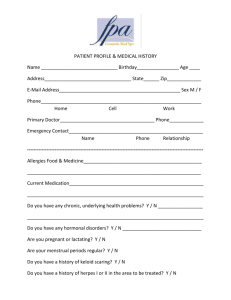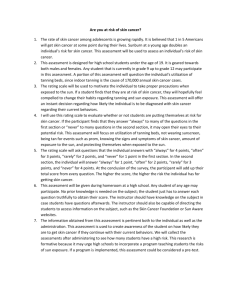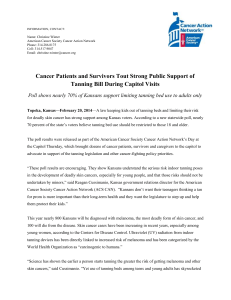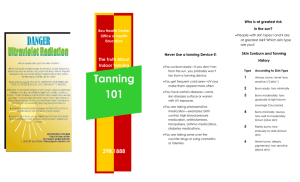Reducing health risks from the use of ultraviolet (UV) tanning equipment Introduction
advertisement
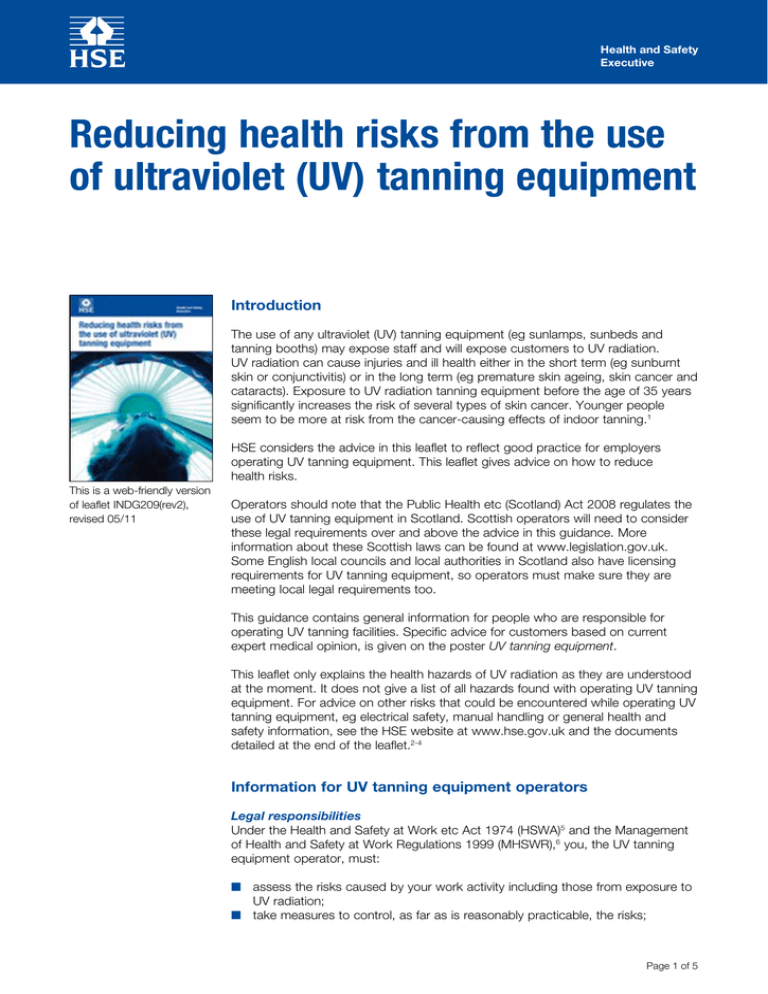
Health and Safety Executive Reducing health risks from the use of ultraviolet (UV) tanning equipment Introduction The use of any ultraviolet (UV) tanning equipment (eg sunlamps, sunbeds and tanning booths) may expose staff and will expose customers to UV radiation. UV radiation can cause injuries and ill health either in the short term (eg sunburnt skin or conjunctivitis) or in the long term (eg premature skin ageing, skin cancer and cataracts). Exposure to UV radiation tanning equipment before the age of 35 years significantly increases the risk of several types of skin cancer. Younger people seem to be more at risk from the cancer-causing effects of indoor tanning.1 HSE considers the advice in this leaflet to reflect good practice for employers operating UV tanning equipment. This leaflet gives advice on how to reduce health risks. This is a web-friendly version of leaflet INDG209(rev2), revised 05/11 Operators should note that the Public Health etc (Scotland) Act 2008 regulates the use of UV tanning equipment in Scotland. Scottish operators will need to consider these legal requirements over and above the advice in this guidance. More information about these Scottish laws can be found at www.legislation.gov.uk. Some English local councils and local authorities in Scotland also have licensing requirements for UV tanning equipment, so operators must make sure they are meeting local legal requirements too. This guidance contains general information for people who are responsible for operating UV tanning facilities. Specific advice for customers based on current expert medical opinion, is given on the poster UV tanning equipment. This leaflet only explains the health hazards of UV radiation as they are understood at the moment. It does not give a list of all hazards found with operating UV tanning equipment. For advice on other risks that could be encountered while operating UV tanning equipment, eg electrical safety, manual handling or general health and safety information, see the HSE website at www.hse.gov.uk and the documents detailed at the end of the leaflet.2-4 Information for UV tanning equipment operators Legal responsibilities Under the Health and Safety at Work etc Act 1974 (HSWA)5 and the Management of Health and Safety at Work Regulations 1999 (MHSWR),6 you, the UV tanning equipment operator, must: ■■ assess the risks caused by your work activity including those from exposure to UV radiation; ■■ take measures to control, as far as is reasonably practicable, the risks; Page 1 of 5 Health and Safety Executive ■■ tell your staff the results of your risk assessment. Make sure they are trained and competent in the operation and use of any tanning equipment; and ■■ if you have five or more employees you must write down the main findings of the assessment. Carrying out the risk assessment is your responsibility though you can seek help and advice, from within your organisation or outside sources (eg consultants). The Approved Code of Practice Management of health and safety at work: Management of Health and Safety at Work Regulations 19996 contains further information about legal responsibilities under the HSWA and MHSWR. Assessing the risk of using UV tanning equipment The purpose of your risk assessment is to help you make an appropriate decision about what you need to do to prevent or control UV radiation exposure levels to people working near or using your UV tanning equipment. A risk assessment does not need to be long or complex, but you do need to work through the following five steps: ■■ ■■ ■■ ■■ ■■ Identify the hazards. Decide who may be harmed and how. Work out the risks and decide on actions. Record your findings (if you employ five or more people) and act on them. Review and monitor your risk assessment and regularly update it if necessary. HSE’s leaflet Five steps to risk assessment2 gives straightforward advice. HSE also publishes example risk assessments to show what is expected. Both can be found at www.hse.gov.uk/risk. The consequences of exposure to the hazard of UV radiation, which can be associated with running and/or using UV tanning equipment, are as follows. Short-term effects ■■ Burns. ■■ Skin dryness and itching. ■■ Eye irritation or conjunctivitis (where suitable goggles are not worn). ■■ Customers becoming trapped if the equipment fails mechanically. Long-term effects ■■ Skin cancer.7-8 ■■ Cataracts (where suitable goggles are not worn). ■■ Premature ageing of the skin, which will look coarse, leathery and wrinkled. Who might be at risk? You need to consider: ■■ ■■ ■■ ■■ employees assisting customers; maintenance staff carrying out repairs or servicing; the customers using the equipment; and other members of the public (adults and under-18s) on the premises. You must inform your employees of the risk of operating and using UV tanning equipment. To control the risk of exposure to UV radiation to your customers, we advise you to provide them with the information on the poster. Reducing health risks from the use of Ultra Violet (UV) tanning equipment Page 2 of 5 Health and Safety Executive Operating your UV tanning equipment safely Following the advice in this section will help you to address the risks associated with using UV tanning equipment. However, this is not a complete list and as a result of your risk assessment, you may have identified other things that need to be done. ■■ You should have received information from the manufacturer or supplier on the correct operation of your UV tanning equipment, and should have familiarised yourself and any employees with it, and be following it. This information should include the correct lamps to use and the maintenance regime. ■■ It is good practice to have trained staff present while customers are using your UV tanning equipment. ■■ You should provide ongoing health and safety training for your staff to make sure they can correctly run the equipment, provide customers with information about the risks and assist as required. ■■ It is good practice that you have effective procedures in place to provide immediate assistance to customers using your UV tanning equipment. ■■ Make sure that children (under 18 years of age) accompanying adults, who are using UV tanning equipment, are not exposed to UV radiation. ■■ If you are operating more than one piece of equipment in the same room, you are recommended to use screening between the units. ■■ It is good practice that you make sure the equipment is cleaned and sanitised between customers. ■■ When you are replacing UV tubes make sure the right type are fitted and reassess the exposure requirements of your customers when subsequently using the equipment. The BS EN standard on manufacturing UV tanning equipment should provide more useful information.9 ■■ Make sure your staff are aware of the risks to themselves from working with UV tanning equipment and how to reduce or avoid these risks. ■■ It is good practice to keep training records for your staff. ■■ It is good practice that you provide adequate eye protection (goggles) for customers and staff, when maintaining equipment. ■■ When carrying out your risk assessment, you are advised to consider the Sunbeds (Regulation) Act 2010, which makes it illegal for under-18s to use commercial UV tanning equipment. HSE would like to thank the following organisations for their contributions to revising this guidance. ■■ ■■ ■■ ■■ ■■ ■■ ■■ ■■ ■■ ■■ ■■ Cancer Research UK. Committee on Medical Aspects of Radiation in the Environment. Sunbed Association. Chartered Institute of Environmental Health. Local Authorities Co-ordinators of Regulatory Services. Welsh Assembly Government. Health and Safety Executive Northern Ireland and Department of Health, Social Service and Public Safety Northern Ireland. Scottish Government. Department of Health. Department for Business, Enterprise and Regulatory Reform. Department of Communities and Local Government. Reducing health risks from the use of Ultra Violet (UV) tanning equipment Page 3 of 5 Health and Safety Executive References 1 The International Agency for Research on Cancer and Working Group on artificial ultraviolet (UV) light and skin cancer ‘The association of use of sunbeds with cutaneous malignant melanoma and other skin cancers: A systematic review’ Int J Cancer 2006 120 1116-1122 2 Five steps to risk assessment Leaflet INDG163(rev2) HSE Books 2006 (priced packs of 10 ISBN 978 0 7176 6189 3) www.hse.gov.uk/pubns/indg163.pdf 3 Maintaining portable electrical equipment in offices and other low-risk environments Leaflet INDG236(rev1) HSE Books 2011 (priced packs of 10 ISBN 978 0 7176 6429 0) www.hse.gov.uk/pubns/indg236.pdf 4 Essentials of health and safety at work (Fourth edition) Guidance HSE Books 2006 ISBN 978 0 7176 6179 4 5 Health and Safety at Work etc Act 1974 (c.37) The Stationery Office 1974 ISBN 978 0 10 543774 1 www.legislation.gov.uk 6 Management of health and safety at work. Management of Health and Safety at Work Regulations 1999. Approved Code of Practice and guidance L21 (Second edition) HSE Books 2000 ISBN 978 0 7176 2488 1 7 Elwood J and Jopson J ‘Melanoma and sun exposure: An overview of published studies’ Int J Cancer 1997 73 198-203 8 Gandini S et al ‘Meta-analysis of risk factors for cutaneous melanoma II. Sun exposure’ Eur J Cancer 2005 41(1) 45-60 9 BS EN 60335-2-27:1997 Specification for safety of household and similar electrical appliances. Particular requirements. Ultra-violet and infra-red skin treatment appliances for household and similar use British Standards Institution Reducing health risks from the use of Ultra Violet (UV) tanning equipment Page 4 of 5 Health and Safety Executive Further information For information about health and safety, or to report inconsistencies or inaccuracies in this guidance, visit www.hse.gov.uk/. You can view HSE guidance online and order priced publications from the website. HSE priced publications are also available from bookshops. British Standards can be obtained in PDF or hard copy formats from BSI: http://shop.bsigroup.com or by contacting BSI Customer Services for hard copies only Tel: 020 8996 9001 email: cservices@bsigroup.com. The Stationery Office publications are available from The Stationery Office, PO Box 29, Norwich NR3 1GN Tel: 0870 600 5522 Fax: 0870 600 5533 email: customer.services@tso.co.uk Website: www.tso.co.uk (They are also available from bookshops.) Statutory Instruments can be viewed free of charge at www.legislation.gov.uk. This leaflet contains notes on good practice which are not compulsory but which you may find helpful in considering what you need to do. This leaflet is available in priced packs of 10 from HSE Books, ISBN 978 0 7176 6437 5. A web version can be found at www.hse.gov.uk/pubns/indg209.pdf. © Crown copyright If you wish to reuse this information visit www.hse.gov.uk/copyright.htm for details. First published 11/10. Published by the Health and Safety Executive 05/11 Page 5 of 5
